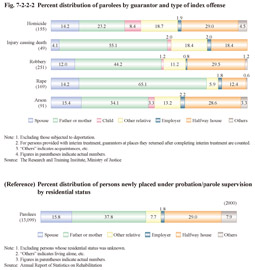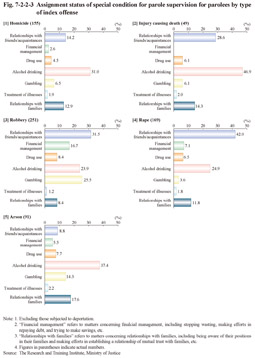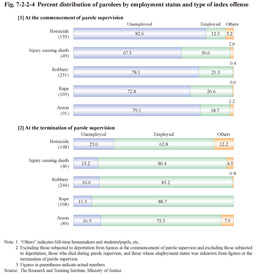2 Treatment in parole supervision
(1) Status of guarantors
Fig. 7-2-2-2 shows the percent distribution of parolees by guarantor and type of index offense. The proportion of those with the guarantor being their father or mother was high for injury causing death and rape, and the proportion of those with the guarantor being a halfway house nearly 30% for homicide, robbery, and arson.
Fig. 7-2-2-2 Percent distribution of parolees by guarantor and type of index offense
(2) Assignment status of special condition for parole supervision
Special conditions for parole supervision were assigned to parolees under the Offenders Prevention and Rehabilitation Act. Fig. 7-2-2-3 shows the assignment status of special condition for parole supervision with the research subjects who were released on parole by type of index offense. The percentage of those for whom special condition for parole supervision concerning alcohol drinking, relationships with friends/acquaintances, and relationships with families were assigned was high for homicide and injury causing death, that concerning relationships with friends/acquaintances, gambling, alcohol drinking, and financial management high for robbery, that concerning relationships with friends/acquaintances and alcohol drinking high for rape, and that concerning alcohol drinking, relationships with families, and gambling high for arson.
Fig. 7-2-2-3 Assignment status of special condition for parole supervision for parolees by type of index offense
(3) Employment status
Fig. 7-2-2-4 shows the percent distribution of research subjects released on parole by employment status at the commencement and termination of their parole supervision and type of index offense. The proportion of those employed at the termination of their parole supervision was overwhelmingly higher than that at the commencement of parole supervision for all offenses.
The percentage of those who were unemployed at the time of the offense (See Subsection 2, Section 1) but were then employed at the termination of their parole supervision was approximately 80% for robbery and rape, approximately 70% for homicide and arson, and 60% for injury causing death.
Fig. 7-2-2-4 Percent distribution of parolees by employment status and type of index offense


